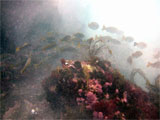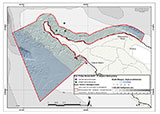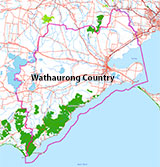Glaneuse Reef
![]() Reef Dive |
Reef Dive | ![]() Shore access
Shore access
![]()
![]()
![]()
![]()
![]()
![]()
Depth: 1 m (3.28 ft) to 5 m (16 ft)
Level: Snorkelling, Open Water and beyond.
The Glaneuse Reef is situated at the western extremity of the Point Lonsdale section of the Port Phillip Heads Marine National Park. It can be accessed from either walking over the dune from the track at Ocean Road (opposite Winterly Road), or slightly longer by walking westward along the back beach from the lighthouse.
The reef is named after the barque Glaneuse that ran ashore on its Western side on 2 October 1886. It was heavily salvaged at the time and it is rarely seen due to the movement of sand over its remains.
The reef itself is a drying reef that becomes exposed during the ebb tide. Once the water has receded a series of shallow rock pools are exposed, that are great for the beginner snorkeler. The pools themselves can become filled up with sand from time to time, but then exposed again after big seas. The diver can see a wide variety of marine vegetation that is both resilient and colourful. Lots of juvenile fish such as Blue-throat wrasse, Sea Sweep and Luderick can be seen under the rocky reef over-hangs. Marine invertebrates including shrimp, sea stars and shellfish can be found hiding among the kelp.
When the tide starts to flood (come in), it is best to leave the water as the swell usually increases with the rising tide.
Location: Corner Ocean Road & Winterly Road, Point Lonsdale, Victoria 3225
MELWAY Ref: Page 499 J7
Beach Marker: 2W
Warning: Glaneuse Reef is a highly hazardous area owing to the waves and strong permanent and shifting rips, together with rocks and reefs. Beach breaks are common over the numerous reefs, with the best being Glaneuse Reef, which is adjacent to The Escalator rip. Always go with a buddy and be extremely careful. Experienced divers and snorkellers only.
Entry/Exit: From the beach opposite Winterly Road at beach marker 2W.
Ideal Conditions: Conditions are usually best with no wind or after a few days of northerlies as surface conditions remain calm. Diving and snorkelling is best with light northerly winds, a low swell at mid to high tide, as the reefs are exposed at low tide.
See WillyWeather (Point Lonsdale Back Beach) as a guide for the tide times and the height of the tide.
Bass Strait Warning: Always keep an eye on sea conditions throughout any shore or boat dive in Bass Strait on Victoria's coastline. Please read the warnings on the web page diving-in-bass-strait before diving or snorkelling this site.
The Rip & Tides Warning: Always keep an eye on sea conditions throughout any shore or boat dive within "The Rip" (aka "The Heads"). This is a dangerous stretch of water, where Bass Straight meets Port Phillip, which has claimed many ships and lives. Please read the warnings on the web page diving-the-rip before diving or snorkelling this site.
Port Phillip Heads Marine National Park
This site lies in the Port Phillip Heads Marine National Park. The park is made up of six separate marine areas around the southern end of Port Phillip: Swan Bay, Mud Islands, Point Lonsdale, Point Nepean, Popes Eye, and Portsea Hole.
Thirty-one of the 120 shipwrecks known to have occurred within a 10 nautical mile radius of Port Phillip Heads are thought to be within the Port Phillip Heads Marine National Park in Point Lonsdale and Point Nepean.
Aboriginal tradition indicates that the Bellarine Peninsula side of the Port Phillip Heads Marine National Park is part of Country of the Wathaurung people, and the Mornington Peninsula side, including Mud Islands, is part of Country of the Boon Wurrung people.
See also, Parks Victoria: Port Phillip Heads Marine National Park,
Park Note: Port Phillip Heads Marine National Park,
Port Phillip Heads Marine National Park - Map,
Divers Guide - Port Phillip Heads Marine National Park,
Port Phillip Heads Marine National Park Identification Booklet, and
Taxonomic Toolkit for the Marine Life of Port Phillip Bay.
You are not permitted to carry a spear gun while snorkelling or scuba diving in Port Phillip Heads Marine National Park.
Traditional Owners — This dive site is in the traditional Country of the Wathaurong (Wadda-Warrung) people of the Kulin Nation. This truly ancient Country includes the coastline of Port Phillip, from the Werribee River in the north-east, the Bellarine Peninsula, and down to Cape Otway in the south-west. We wish to acknowledge the Wathaurong as Traditional Owners. We pay respect to their Ancestors and their Elders, past, present and emerging. We acknowledge Bunjil the Creator Spirit of this beautiful land, who travels as an eagle, and Waarn, who protects the waterways and travels as a crow, and thank them for continuing to watch over this Country today and beyond.
Glaneuse Reef Location Map
Latitude: 38° 17.481′ S (38.29135° S / 38° 17′ 28.86″ S)
Longitude: 144° 36.457′ E (144.607617° E / 144° 36′ 27.42″ E)
Datum: WGS84 |
Google Map
| Get directions
Added: 2020-07-16 15:48:32 GMT, Last updated: 2022-04-07 17:42:23 GMT
Source: Divers Guide - Port Phillip Heads Marine National Park
Nearest Neighbour: Point Lonsdale Back Beach, 395 m, bearing 310°, NW
Port Phillip Heads Marine National Park.
Point Lonsdale, Bellarine Peninsula.
Depth: 1 to 5 m.
[ Top ]
DISCLAIMER: No claim is made by The Scuba Doctor as to the accuracy of the dive site coordinates listed here. Should anyone decide to use these GPS marks to locate and dive on a site, they do so entirely at their own risk. Always verify against other sources.
The marks come from numerous sources including commercial operators, independent dive clubs, reference works, and active divers. Some are known to be accurate, while others may not be. Some GPS marks may even have come from maps using the AGD66 datum, and thus may need be converted to the WGS84 datum. To distinguish between the possible accuracy of the dive site marks, we've tried to give each mark a source of GPS, Google Earth, or unknown.









